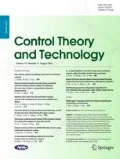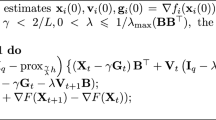Abstract
This paper considers the problem of constructing a direct coupling quantum observer for a closed linear quantum system. The proposed distributed observer consists of a network of quantum harmonic oscillators and it is shown that the observer network converges to a consensus in a time averaged sense in which each element of the observer estimates the specified output of the quantum plant. An example and simulations are included to illustrate the properties of the observer network.
Similar content being viewed by others
References
Z. Miao, M. R. James, I. R. Petersen. Coherent observers for linear quantum stochastic systems. Automatica, 2016, 71: 264–271.
I. Vladimirov, I. R. Petersen. Coherent quantum filtering for physically realizable linear quantum plants. Proceedings of the European Control Conference, Zurich, Switzerland: IEEE, 2013: 2717–2723.
Z. Miao, L. A. D. Espinosa, I. R. Petersen, et al. Coherent quantum observers for n-level quantum systems. Proceedings of the Australian Control Conference, Perth, Australia: IEEE, 2013: 313–318.
I. G. Vladimirov, I. R. Petersen. Directly coupled observers for quantum harmonic oscillators with discounted mean square cost functionals and penalized back-action. Proceedings of the IEEE Conference on Norbert Wiener in the 21st Century, Melbourne, Australia: IEEE, 2016: 78–83.
M. R. James, H. I. Nurdin, I. R. Petersen. H∞ control of linear quantum stochastic systems. IEEE Transactions on Automatic Control, 2008, 53(8): 1787–1803.
H. I. Nurdin, M. R. James, I. R. Petersen. Coherent quantum LQG control. Automatica, 2009, 45(8): 1837–1846.
A. J. Shaiju, I. R. Petersen. A frequency domain condition for the physical realizability of linear quantum systems. IEEE Transactions on Automatic Control, 2012, 57(8): 2033–2044.
I. R. Petersen. Quantum linear systems theory. Open Automation and Control Systems Journal, 2016, 8: 67–93.
C. Gardiner, P. Zoller. Quantum Noise. Berlin: Springer, 2000.
H. Bachor, T. Ralph. A Guide to Experiments in Quantum Optics. 2nd ed. Weinheim, Germany: Wiley-VCH, 2004.
A. I. Maalouf, I. R. Petersen. Bounded real properties for a class of linear complex quantum systems. IEEE Transactions on Automatic Control, 2011, 56(4): 786–801.
H. Mabuchi. Coherent-feedback quantum control with a dynamic compensator. Physical Review A, 2008, 78(3): DOI 10.1103/PhysRevA.78.032323.
G. Zhang, M. James. Direct and indirect couplings in coherent feedback control of linear quantum systems. IEEE Transactions on Automatic Control, 2011, 56(7): 1535–1550.
I. G. Vladimirov, I. R. Petersen. A quasi-separation principle and Newton-like scheme for coherent quantum LQG control. Systems & Control Letters, 2013, 62(7): 550–559.
I. Vladimirov, I. R. Petersen. A dynamic programming approach to finite-horizon coherent quantum LQG control. Proceedings of the Australian Control Conference, Melbourne, Australia: IEEE, 2011: 357–362.
R. Hamerly, H. Mabuchi. Advantages of coherent feedback for cooling quantum oscillators. Physical Review Letters, 2012, 109(17): DOI 10.1103/PhysRevLett.109.173602.
N. Yamamoto. Coherent versus measurement feedback: Linear systems theory for quantum information. Physical Review X, 2014, 4(4): DOI 10.1103/PhysRevX.4.041029.
C. Xiang, I. R. Petersen, D. Dong. Coherent robust H-infinity control of linear quantum systems with uncertainties in the Hamiltonian and coupling operators. Automatica, 2017, 81: 8–21.
C. Xiang, I. R. Petersen, D. Dong. Performance analysis and coherent guaranteed cost control for uncertain quantum systems using small gain and Popov methods. IEEE Transactions on Automatic Control, 2017, 62(3): 1524–1529.
S. L. Vuglar, I. R. Petersen. Quantum noises, physical realizability and coherent quantum feedback control. IEEE Transactions on Automatic Control, 2017, 62(2): 998–1003.
F. L. Lewis, H. Zhang, K. Hengser-Movric, et al. Cooperative Control of Multi-Agent Systems. London: Springer, 2014.
G. Shi, K. H. Johansson. Robust consusus for continuous-time multi-agent dynamics. SIAM Journal on Control and Optimization, 2013, 51(5): 3673–3691.
M. Mesbahi, M. Egerstedt. Graph Theoretic Methods in Multiagent Networks. Princeton: Princeton University Press, 2010.
L. Xiao, S. Boyd. Fast linear iterations for distributed averaging. Systems & Control Letters, 2005, 53(1): 65–78.
A. Jadbabaie, J. Lin, A. Morse. Coordination of groups of mobile autonomous agents using nearest neighbor rules. IEEE Transactions on Automatic Control, 2003, 48(6): 988–1001.
R. Olfati-Saber. Distributed Kalman filter with embedded consensus filters. Proceedings of the 44th IEEE Conference on Decision and Control and the European Control Conference, Seville, Spain: IEEE, 2005: 8179–8184.
R. Olfati-Saber. Kalman-consensus filter: optimality, stability, and performance. Proceedings of the 48th IEEE Conference on Decision and Control and 28th Chinese Control Conference, Shanghai: IEEE, 2009: 7036–7042.
R. Sepulchre, A. Sarlette, P. Rouchon. Consensus in noncommutative spaces. Proceedings of the 49th IEEE Conference on Decision and Control, Atlanta: IEEE, 2010: 6596–6601.
L. Mazzarella, A. Sarlette, F. Ticozzi. Consensus for quantum networks: symmetry from gossip interactions. IEEE Transactions on Automatic Control, 2015, 60(1): 158–172.
L. Mazzarella, F. Ticozzi, A. Sarlette. From consensus to robust randomized algorithms: a symmetrization approach. arXiv, 2013: arXiv:1311.3364 [quant-ph].
F. Ticozzi, L. Mazzarella, A. Sarlette. Symmetrization for quantum networks: a continuous-time approach. arXiv, 2014: arXiv:1403.3582 [quant-ph].
G. Shi, D. Dong, I. R. Petersen, et al. Consensus of quantum networks with continuous-time Markovian dynamics. Proceedings of the 11th World Congress on Intelligent Control and Automation, Shenyang: IEEE, 2014: 307–312.
I. R. Petersen. A direct coupling coherent quantum observer. IEEE Conference on Control Applications, Nice, France, 2014: 1960–1963.
I. R. Petersen. Time averaged consensus in a direct coupled distributed coherent quantum observer. Proceedings of the American Control Conference, Chicago: IEEE, 2015: 80–85.
I. R. Petersen. Time averaged consensus in a direct coupled coherent quantum observer network for a single qubit finite level quantum system. Proceedings of the 10th Asian Control Conference, Kota Kinabalu, Malaysia: IEEE, 2015: DOI 10.1109/ASCC.2015.7244397.
I. R. Petersen. A direct coupling coherent quantum observer for a single qubit finite level quantum system. Proceedings of the 4th Australian Control Conference, Canberra, Australia: IEEE, 2014: 72–76.
I. R. Petersen, E. H. Huntington. A possible implementation of a direct coupling coherent quantum observer. Proceedings of the 5th Australian Control Conference, Gold Coast, Australia: IEEE, 2015: 105–107.
I. R. Petersen, E. H. Huntington. Implementation of a direct coupling coherent quantum observer including observer measurements. Proceedings of the American Control Conference, Boston: IEEE, 2016: 4765–4768.
I. R. Petersen, E. H. Huntington. A reduced order direct coupling coherent quantum observer for a complex quantum plant. Proceedings of the European Control Conference, Aalborg, Denmark: IEEE, 2016: 1430–1433.
I. R. Petersen, E. H. Huntington. Implementation of a distributed coherent quantum observer. arXiv, 2017: arXiv:1702.06215 [quant-ph].
J. Gough, M. R. James. The series product and its application to quantum feedforward and feedback networks. IEEE Transactions on Automatic Control, 2009, 54(11): 2530–2544.
Author information
Authors and Affiliations
Corresponding author
Additional information
This work was supported by the Air Force Office of Scientific Research (AFOSR), under agreement number FA2386-16-1-4065. Some of the research presented in this paper was also supported by the Australian Research Council under grant FL110100020.
Ian R. PETERSEN was born in Victoria, Australia. He received a Ph.D in Electrical Engineering in 1984 from the University of Rochester. From 1983 to 1985 he was a Postdoctoral Fellow at the Australian National University. From 1985 until 2016 he was with UNSW Canberra where was most recently a Scientia Professor and an Australian Research Council Laureate Fellow in the School of Engineering and Information Technology. From 2017 he has been a Professor in the Research School of Engineering at the Australian National University. He has served as an Associate Editor for the IEEE Transactions on Automatic Control, Systems and Control Letters, Automatica, and SIAM Journal on Control and Optimization. Currently he is an Editor for Automatica and an Associate Editor for the IEEE Transactions on Control Systems Technology. He is a fellow of IFAC, the IEEE and the Australian Academy of Science. His main research interests are in robust control theory, quantum control theory and stochastic control theory.
Rights and permissions
About this article
Cite this article
Petersen, I.R. Time averaged consensus in a direct coupled coherent quantum observer network. Control Theory Technol. 15, 163–176 (2017). https://doi.org/10.1007/s11768-017-7019-8
Received:
Revised:
Accepted:
Published:
Issue Date:
DOI: https://doi.org/10.1007/s11768-017-7019-8




